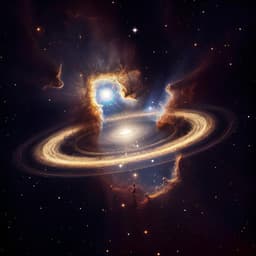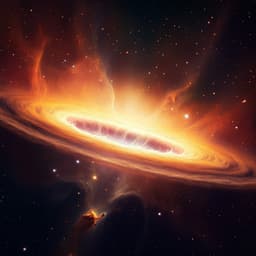
Space Sciences
A small and vigorous black hole in the early Universe
R. Maiolino, J. Scholtz, et al.
This groundbreaking research unveils the intricate details of GN-z11, a luminous galaxy at redshift z = 10.6. The JWST-NIRSpec spectrum suggests the presence of an accreting black hole, supported by semi-forbidden lines indicative of high gas densities and rapid outflows, leading to insights about its exceptional luminosity and nitrogen abundance. This study was conducted by a team of expert researchers.
~3 min • Beginner • English
Introduction
The study investigates whether the exceptionally luminous z = 10.6 galaxy GN-z11 hosts an actively accreting black hole, addressing how early black hole seeds form and grow rapidly in the first few hundred Myr after the Big Bang. Prior JWST imaging revealed a compact nuclear component and a few-hundred-parsec disc-like component, and an initial NIRSpec spectrum was consistent with star formation, though an AGN could not be excluded. Using a deeper NIRSpec spectrum, the authors test the AGN scenario by searching for unambiguous AGN tracers, high gas-density indicators characteristic of broad line regions, and signatures of fast outflows. Establishing an accreting black hole at such early times informs competing models of black hole seeding and growth (heavy seeds versus light/intermediate seeds with super-Eddington accretion) and helps explain the extreme luminosities of some high-z galaxies.
Literature Review
The work is motivated by theoretical frameworks that predict different initial black hole seed masses and growth histories, including direct collapse black holes, remnants of Population III stars, and formation via dense star clusters. Observationally, massive black holes at z ≈ 6–7 challenge growth timescales, motivating searches for earlier, smaller black holes. Previous spectroscopy of GN-z11 suggested vigorous star formation and potentially enhanced nitrogen, but did not rule out an AGN. Diagnostic ultraviolet emission lines have been developed to distinguish AGN activity from star formation, with [Ne v]/[Ne IV], C II*, and high-density semi-forbidden transitions (e.g., N IV], N III]) serving as key indicators. The literature also discusses classes of AGN with relatively narrow broad lines (Narrow Line Seyfert 1s) that can exhibit super-Eddington accretion, as well as BAL, mini-BAL, and NAL quasars characterized by blueshifted CIV absorption. Scenarios invoking Wolf-Rayet stars have been proposed for some high-ionization features, but specific line combinations and densities often contradict a pure stellar origin.
Methodology
- Observations: Analysis of deep JWST/NIRSpec spectroscopy of GN-z11 at z = 10.603.
- Line detections and modeling: Identification and Gaussian modeling (single/multiple components) of key ultraviolet lines, including [Ne v]λλ2422–2424 (AGN tracer) and C II*λ1335, as well as density-sensitive semi-forbidden nitrogen lines N IV]λ1486 and the N III] multiplet (1748.6, 1749.7, 1752.2, 1754.0 Å).
- Density diagnostics: Use of critical densities and measured flux ratios to infer gas densities. The detection of N IV]λ1486 (critical density 4.7×10^7 cm−3) and non-detection of [N IV]λ1483 (critical density 1.5×10^5 cm−3) imply very high densities. For the N III] multiplet, atomic-physics-constrained ratios (F1754/F1749 = 1.05; F1746/F1752 = 0.14) and the measured resolved fraction of the 1754.0 Å component (0.25 ± 0.04 of the total multiplet) were compared against extensive Cloudy photoionization grids (varying metallicity, ionization parameter, and AGN vs. stellar ionizing spectra). These comparisons constrain the emitting gas to n ≥ 10^9 cm−3 (3σ; ≥10^10 cm−3 at 2σ), within the BLR regime and inconsistent with typical ISM densities (10^−1–10^3 cm−3, rarely up to a few ×10^4 cm−3).
- Kinematics: Measurement of line widths for semi-forbidden and permitted lines (Mg II, N III], N IV]) in the range of ≈430–470 km s−1, with [Ne III] narrower (340 ± 30 km s−1), indicating different emitting regions (BLR/NLR/ISM contributions). Identification and characterization of a deep, blueshifted CIVλλ1548,1550 absorption trough to derive outflow velocities of ≈800–1,000 km s−1; detection of a redshifted CIV emission component consistent with a resonant scattering counterpart to Lyα.
- AGN versus stellar origin tests: Comparison of CIV absorption depth and shape to stellar wind templates at metallicities consistent with GN-z11 (Z ≈ 0.1 Z☉), demonstrating that the observed deep trough exceeds expectations from stellar winds and typical star-forming galaxy outflows. Consideration of WR-star diagnostics (e.g., N IV λ1718 P-Cygni) and their absence, along with the presence of [Ne v]/[Ne IV] and C II*, argues against a dominant WR origin.
- Black hole mass and accretion rate: Application of local virial scaling relations using line widths and continuum luminosity to estimate the black hole mass MBH ≈ 1.6×10^6 M☉ (log(MBH/M☉) = 6.2 ± 0.3). Bolometric luminosity inferred to be ≈10^45 erg s−1, implying accretion at ~5× the Eddington rate (uncertainty ~×2). Alternative assumption of Eddington-limited accretion considered as a systematic check.
- Evolutionary context: Comparison of the inferred MBH with seeding and growth tracks from semi-analytic models and simulations under Eddington and super-Eddington assumptions. Placement of GN-z11 on the MBH–M⋆ plane using an extended disc stellar mass M⋆ ≈ 8×10^8 M☉ to compare with local relations and high-z AGN samples.
Key Findings
- Clear AGN signatures: Detection of [Ne v]λ2423 (doublet near 2422–2424 Å) and C II*λ1335, lines generally absent in purely star-forming galaxies and indicative of AGN activity.
- Extremely high gas densities: Semi-forbidden nitrogen line diagnostics (N IV], N III]) require n ≥ 10^9 cm−3 (3σ; ≥10^10 cm−3 at 2σ), consistent with AGN broad line region conditions and incompatible with ISM H II regions.
- Outflow detection: A deep, blueshifted CIV absorption trough indicates an outflow with velocity ≈800–1,000 km s−1; accompanying redshifted CIV emission is consistent with resonant scattering and the Lyα profile.
- Line widths: Permitted and semi-forbidden lines (e.g., Mg II, N III], N IV]) have FWHM ≈430–470 km s−1; [Ne III] is narrower (340 ± 30 km s−1), suggesting multi-component (BLR/NLR/ISM) origins and an NLSy1-like AGN with relatively small MBH.
- Black hole mass and accretion: MBH = 10^(6.2 ± 0.3) M☉ (≈1.6×10^6 M☉), with Lbol ≈ 10^45 erg s−1, implying accretion at ~5× the Eddington rate (± factor ≈2).
- Consistency with growth models: The inferred mass and super-Eddington accretion are consistent with heavy seed scenarios, as well as intermediate/light seeds experiencing episodic super-Eddington phases. Sub-Eddington evolution from such a seed could reach MBH ≈ 10^7–10^9 M☉ by z ≈ 6–7, matching known quasar black holes.
- MBH–M⋆ relation: With M⋆ ≈ 8×10^8 M☉ for the extended disk, GN-z11 lies above the local MBH–M⋆ relation but remains marginally consistent within scatter, as expected in early growth phases involving DCBHs and/or super-Eddington accretion.
- Nitrogen enrichment: The high N/O inferred for GN-z11 is compatible with an AGN BLR whose small gas mass (a few M☉ implied by Lyα luminosity) can be rapidly enriched to near-solar or super-solar levels by one or a few supernovae, explaining the ‘nitrogen-loud’ character without invoking extreme global metallicities.
Discussion
The combination of AGN-specific lines ([Ne v]/[Ne IV], C II*), BLR-like gas densities from semi-forbidden nitrogen diagnostics, and a high-velocity CIV outflow demonstrates that GN-z11 hosts an accreting black hole at z = 10.6. The relatively modest line widths, comparable between permitted and semi-forbidden transitions, and super-Eddington accretion rate are characteristic of low-mass, NLSy1-like AGN. These observations directly address the question of early black hole growth by showing that compact, actively accreting black holes existed within the first few hundred Myr, providing pathways to the supermassive black holes powering z ≈ 6–7 quasars. The measured MBH and accretion rate align with both heavy seed models and scenarios where lighter seeds undergo intermittent super-Eddington episodes. Placement above the local MBH–M⋆ relation is expected in early growth phases and supports rapid central mass build-up. The AGN framework also naturally explains GN-z11’s exceptional luminosity and its elevated nitrogen abundance via localized BLR enrichment, alleviating tensions with galaxy formation models that otherwise struggle to produce such luminous, metal-enriched systems at high redshift.
Conclusion
This study provides spectroscopic evidence that the z = 10.6 galaxy GN-z11 hosts a vigorously accreting, relatively low-mass black hole. AGN diagnostic lines, BLR-density indicators, and a fast CIV outflow support an NLSy1-like, mini-BAL/NAL AGN scenario. The inferred black hole mass (log MBH/M☉ ≈ 6.2) accreting at ~5× Eddington is compatible with several seeding models, including heavy seeds with Eddington-limited growth and lighter/intermediate seeds with super-Eddington phases. The AGN interpretation explains GN-z11’s extreme luminosity and nitrogen enrichment and suggests that some of the most luminous high-z galaxies may host accreting black holes, reducing tension with theoretical predictions. Future deeper and higher-resolution spectroscopy, reverberation mapping proxies, and multi-wavelength observations (e.g., X-ray, radio) could refine MBH and accretion estimates, test scaling relations at early epochs, and assess how representative GN-z11 is of the broader luminous high-z galaxy population.
Limitations
- Black hole mass and accretion rate rely on local virial scaling relations, which may not strictly apply at z ≈ 10.6, introducing systematic uncertainties.
- The bolometric luminosity and Eddington ratio estimates carry uncertainties of approximately a factor of two.
- Some permitted and semi-forbidden lines can have contributions from the host galaxy ISM or the AGN narrow line region, complicating decomposition and line-based diagnostics.
- The absence of very broad (thousands of km s−1) lines typical of type-1 AGN is interpreted as a consequence of the small MBH, but alternative geometries or obscuration could also play roles.
- A contribution from Wolf-Rayet stars cannot be completely excluded, though several observed features are inconsistent with a dominant WR origin.
- Some institutional affiliations for a subset of co-authors are not specified in the provided text excerpt, limiting precise attribution.
Related Publications
Explore these studies to deepen your understanding of the subject.







